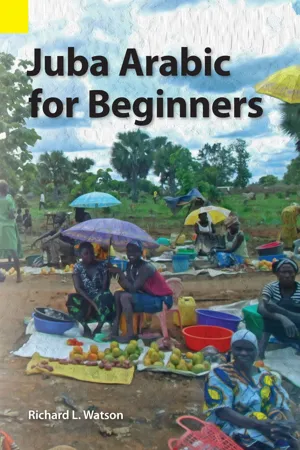
- 212 pages
- English
- ePUB (mobile friendly)
- Available on iOS & Android
Juba Arabic for Beginners
About This Book
Juba Arabic is an Arabic creole closely related to Kinubi. It began developing in the Equatoria Region of what is now South Sudan over 100 years ago, and spread widely, now being the spoken lingua franca of the region. It has become so well established that expatriates working in Equatoria often find themselves in situations in which neither English nor Khartoum colloquial Arabic is adequate for communication. Juba Arabic for Beginners was originally prepared by SIL as a language course for the communication needs of its own personnel, but other people needing to communicate in Juba have found it invaluable. The present course was adapted from the excellent Sudanese Colloquial Arabic for Beginners (Andrew and Janet Persson, with Ahmad Hussein) in general format with its 30 dialogues. However, due to important linguistic and cultural differences, five additional lessons relevant to southern culture are included. This course is written in a Romanized orthography and represents a widespread dialect of Juba Arabic. Over the past 30 years, the course has served, and continues to serve, personnel of a number of expatriate organizations.
Frequently asked questions
Information
1# Introduction to the course
- Dialogue: First, students should listen as the teacher reads through the whole dialogue. After finishing, the teacher will read each phrase or full sentence separately; students should then repeat after the instructor, taking care to imitate the pronunciation and intonation as closely as possible. Finally, the teacher should read through the entire dialogue once again. These dialogues should be memorized for thorough learning and use in practical situations.1
- Vocabulary: Students should memorize the vocabulary for each lesson. It is extremely difficult to make conversation unless students can recall basic vocabulary without conscious effort.
- Notes and drills: Students should read through the explanations and examples beforehand, then work through the drills with the teacher. Each drill should be performed in accordance with the instructions. For more practice, extra drills can be constructed resembling those in the lessons.
- Questions for practice: Students should practice the sample questions and answers, making up additional questions and answers as they practice. One of the keys to successful language learning is to “learn a little and use it a lot” (a phrase borrowed from Brewster and Brewster 1977:1). For this reason, it is important for students to learn to use their growing vocabulary in every situation as soon as possible and as often as possible.
2# Pronounication
2.1 The consonant sounds


Table of contents
- Foreword
- Abbreviations
- 1# Introduction to the course
- 2# Pronounication
- Lesson 1 : Deris nimira wahid
- Lesson 2 : Deris nimira itiniin
- Lesson 3 : Deris nimira talaata
- Lesson 4 : Deris nimira arba
- Lesson 5 : Deris nimira kamsa
- Asilaat le muraaja min deris nimira wahid le kamsa
- Lesson 6 : Deris nimira sita
- Lesson 7 : Deris nimira arba
- Lesson 8 : Deris nimira tamaanya
- Lesson 9 : Deris nimira arba
- Lesson 10 : Deris nimira ashara
- Asilaat le muraaja min deris nimira sita le ashara
- Lesson 11 : Deris nimira hidaasher
- Lesson 12 : Deris nimira itnaasher
- Lesson 13 : Deris nimira talataasher
- Lesson 14 : Deris nimira arba
- Lesson 15 : Deris nimira kamastaasher
- Asilaat le muraaja min deris nimira wahid le kamsa
- Lesson 16 : Deris nimira sitaasher
- Lesson 17 : Deris nimira sabataasher
- Lesson 18 : Deris nimira tamantaasher
- Lesson 19 : Deris nimira tisataasher
- Lesson 20 : Deris nimira ishriin
- Asilaat le muraaja min deris nimira wahid le ishriin
- Lesson 21 : Deris nimira wahid u ishriin
- Lesson 22 : Deris nimira itiniin u ishriin
- Lesson 23 : Deris nimira talaata u ishriin
- Lesson 24 : Deris nimira arba u ishriin
- Lesson 25 : Deris nimira kamsa u ishriin
- Lesson 26 : Deris nimira sita u ishriin
- Lesson 27 : Deris nimira saba u ishriin
- Lesson 28 : Deris nimira tamaanya u ishriin
- Lesson 29 : Deris nimira tisa u ishriin
- Lesson 30 : Deris nimira teletiin
- Lesson 31 : Deris nimira itiniin u teletiin
- Lesson 32 : Deris nimira telaata u teletiin
- Lesson 33 : Deris nimira arba u teletiin
- Lesson 34 : Deris nimira kamsa u teletiin
- Glossaries
- References